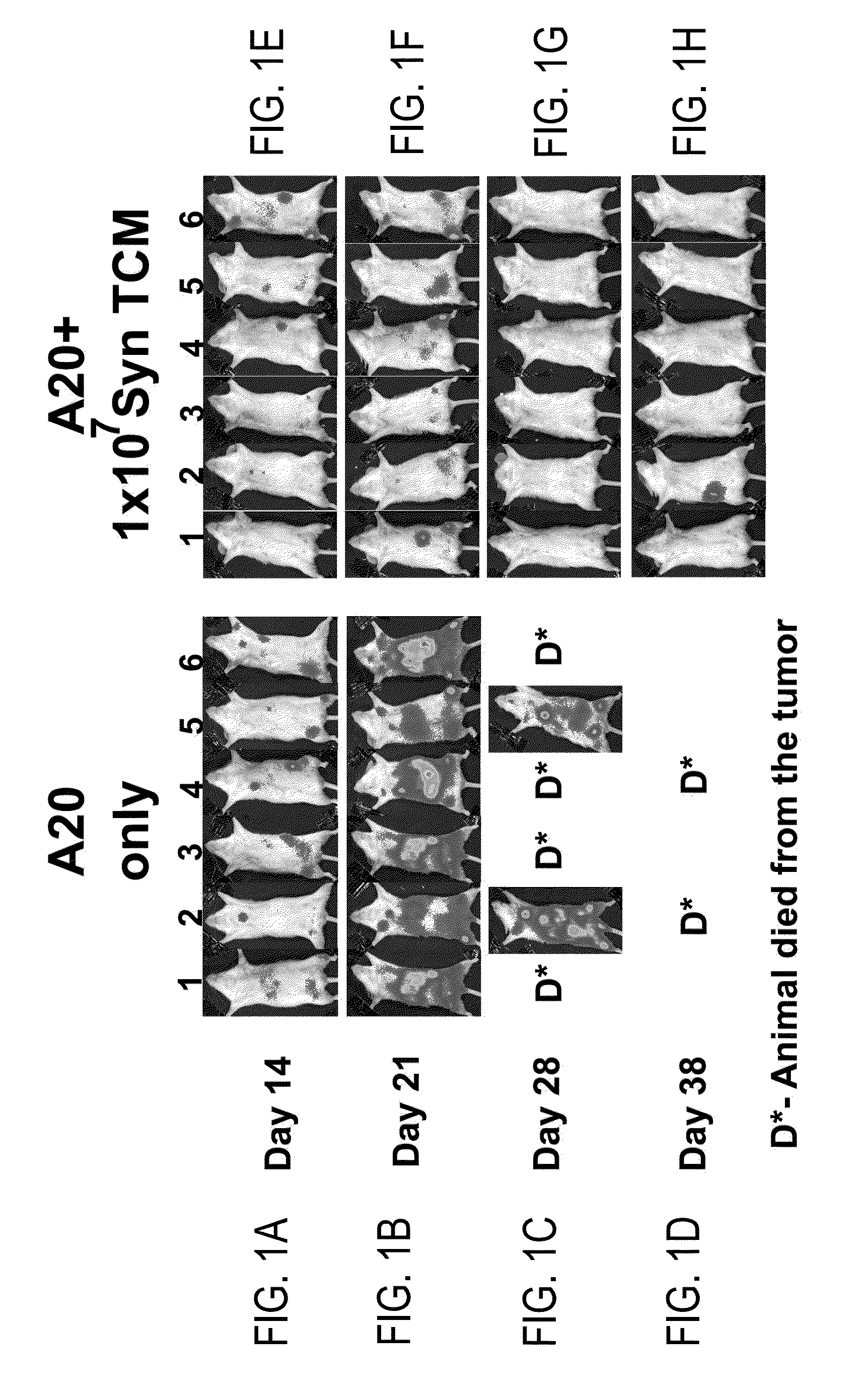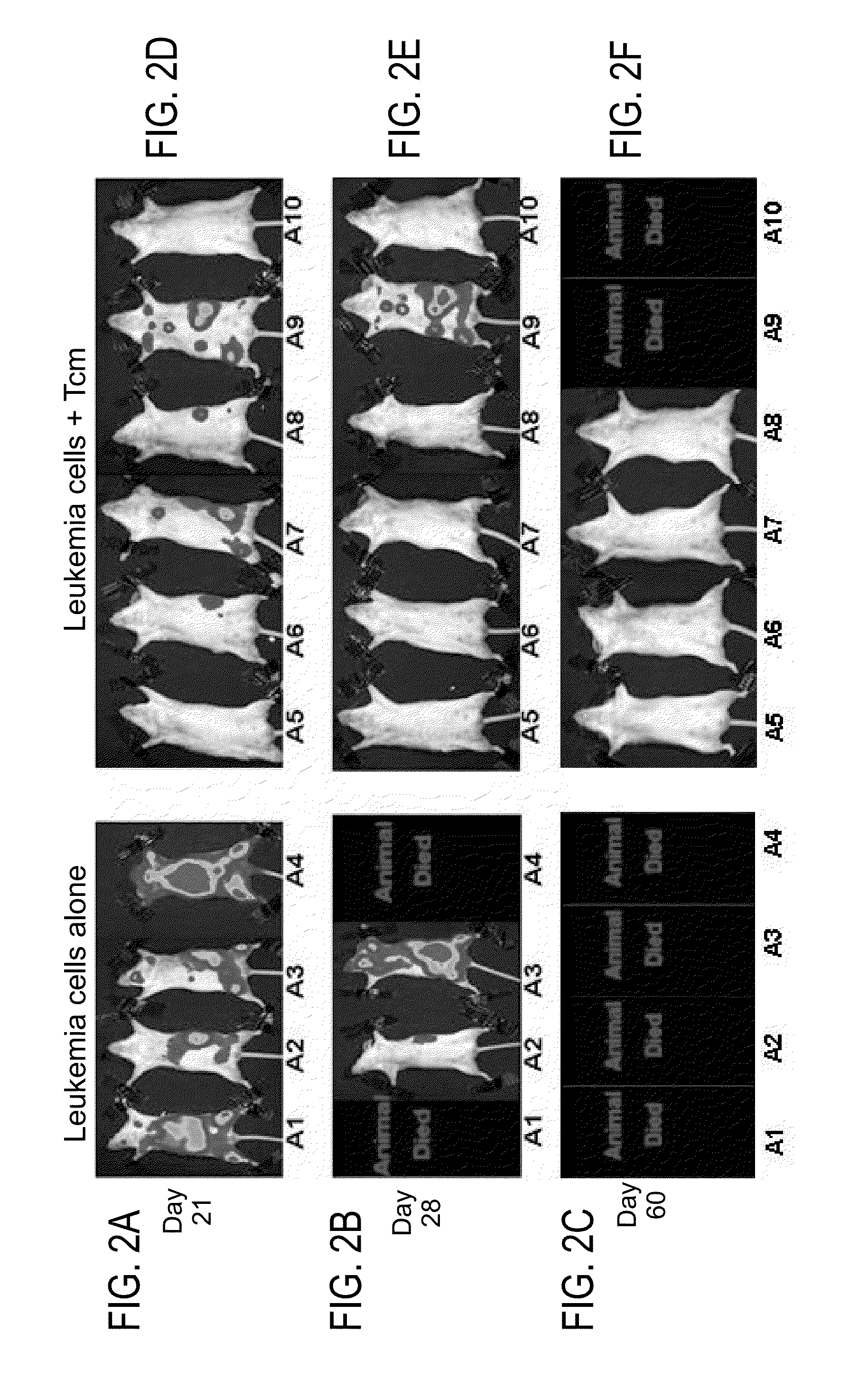Use of anti third party central memory T cells for anti-leukemia/lymphoma treatment
a technology of anti-third party central memory t cells and lymphoma, which is applied in the direction of biocide, antibody medical ingredients, drug compositions, etc., can solve the problems of adversely affecting transplant-related mortality
- Summary
- Abstract
- Description
- Claims
- Application Information
AI Technical Summary
Benefits of technology
Problems solved by technology
Method used
Image
Examples
example 1
Establishment of a Mouse Model
[0193]To establish an appropriate mouse model, inventors initially verified that anti-3rd party Tcm cells derived from (B6×BALB / c)F1 exhibit TCR independent killing of A20 lymphoma cells of BALB / c origin (34.8±12.1% in 4 experiments, 5:1 Tcm / lymphoma cell ratio, in comparison to A20 cells incubated without Tcm, p<0.05). Moreover, after 16 hours of incubation with Tcm cells, AnnexinV staining of A20 cells was significantly enhanced compared to basal staining level (14.8±4.5% and 5.2±2.2% respectively, in 3 experiments, p<0.05), suggesting an apoptosis based mechanism, similar to that previously described for killing of human lymphoma cells [Lask A et al. (submitted 2010); Arditti F D et al., Blood (2005) 105:3365-3371].
example 2
Treatment Protocol by Syngeneic Bone Marrow Transplant and Tcm Cells
[0194]Using luciferase expressing A20 cells, inventors were able to follow the fate of the malignant cells in vivo, and study the anti-lymphoma effect of added donor anti-3rd party Tcm to either syngeneic or allogeneic bone marrow transplant (BMT, hereinbelow), in a model simulating minimal residual disease. In the syngeneic model, 3×106 Nude BALB / c BM cells were transplanted into lethally irradiated BALB / c mice together with 5000 A20 cells. On the next day, syngeneic Tcm were infused. As can be seen in FIGS. 1A-D, none of the untreated mice survived (0 / 7) 100 days post bone marrow transplant (BMT, 23 days median survival). However, administration of 1×107 or 2×107 syngeneic Tcm cells led to significantly diminished tumor burden (FIGS. 1E-H) and improved overall survival of 28% of mice (2 / 7, P<0.0001) and 40% of mice (2 / 5, P<0.002) 100 days post BMT, with median survival of 49 and 80 days, respectively (FIG. 1I).
example 3
Treatment Protocol by Syngeneic Bone Marrow Transplant and Allogeneic Tcm Cells
[0195]An earlier study performed in our lab [Ophir E. et al., Blood (2010) 115: 2095-2104] showed that anti-3rd party Tcm cells are endowed with tolerizing activity, translated into prolonged persistence following BMT, even when using partially matched donors. Inventors therefore tested in the above described syngeneic BMT model the anti-lymphoma effect of 2×107 F1 (CB6) derived Tcm cells, replacing the syngeneic Tcm cells administered previously. Although these F1 derived Tcm cells were expected to be rejected due to MHC disparity, they were continuously present and not rejected even 2 month after transplantation (data not shown). Their long term persistence was probably the result of their tolerizing activity described above. The significant clinical effect of these F1 derived Tcm cells was demonstrated by an improved overall survival of 57.1% mice (4 / 7, FIGS. 2D-G) in comparison to 0% mice (0 / 5, FIGS. ...
PUM
| Property | Measurement | Unit |
|---|---|---|
| concentration | aaaaa | aaaaa |
| concentration | aaaaa | aaaaa |
| concentration | aaaaa | aaaaa |
Abstract
Description
Claims
Application Information
 Login to View More
Login to View More - R&D
- Intellectual Property
- Life Sciences
- Materials
- Tech Scout
- Unparalleled Data Quality
- Higher Quality Content
- 60% Fewer Hallucinations
Browse by: Latest US Patents, China's latest patents, Technical Efficacy Thesaurus, Application Domain, Technology Topic, Popular Technical Reports.
© 2025 PatSnap. All rights reserved.Legal|Privacy policy|Modern Slavery Act Transparency Statement|Sitemap|About US| Contact US: help@patsnap.com



